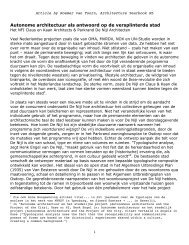ABCD Lars & Roemer
ABCD Lars & Roemer
ABCD Lars & Roemer
Create successful ePaper yourself
Turn your PDF publications into a flip-book with our unique Google optimized e-Paper software.
<strong>Roemer</strong> van Toorn in conversation with <strong>Lars</strong> Lerup <br />
aesthetic complexity. Quasi-objects invite the user to complete them through<br />
action – by relating to them in movement. In that sense they also have a moral<br />
obligation: after all, they need to be used. How do you see the architecture object?<br />
Some of your furniture designs seem to act like quasi-objects (Room, 19??): they<br />
migrate into the field of the sensory, one that is tactile, auditory, and visual.<br />
Meanwhile your housing designs, like the Nofamily House, Love/House, Texas<br />
Zero (Planned Assaults, 1987), “function” like sentences, creating fiction (drama)<br />
out of familiar narratives. Did your perception of the object change over time,<br />
from telling stories (representation) to enacting events (presence)…?<br />
I am entirely in agreement here. I find the idea of quasi-objects<br />
extremely useful. One of my fundamental beliefs, as I have said,<br />
comes from cybernetics and Heinz von Foerster’s dictum that “in<br />
order to see, we must act.” This makes it clear that our existence is<br />
driven – indeed motivated by – action, by leaps of faith. It suggests in<br />
turn that inanimate objects are incredibly important because they<br />
may help us to see things in new and inspiring ways. In this sense I<br />
am all for the exploration of new form. Maybe more intriguingly,<br />
objects can be more or less “quasi.” An all too familiar object becomes<br />
just a servant in our daily errands – a mere tool to be used up – while<br />
unfamiliar objects are more alive, more tentative, more ambiguous,<br />
and therefore more “quasi,” suggesting that new form is essential for<br />
our advancement. As you say, these objects begin to infiltrate us and<br />
become more lifelike, more like verbs…<br />
R as in Ruins<br />
Cities are full of fabricated memories at the expense of the original experience.<br />
Hidden and controversial memories of a place often disappear. Peter Eisenman’s<br />
recent war memorial in Berlin not only dismantles but also neutralizes much of<br />
war’s horror with its formal architectural gesture. He creates a ruin without<br />
memory. What role does the memory of the city – the idea of history – play in<br />
your work? Walter Benjamin in his Arcades project represents and critiques the<br />
23






